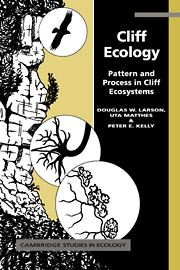6 - Controlling processes
Published online by Cambridge University Press: 16 September 2009
Summary
While inaccessibility has protected cliffs from significant amounts of disturbance, it has also limited the amount of experimental work that deals with questions of the genesis and maintenance of cliff communities. Most previous studies have inferred mechanisms of community or ecosystem function from descriptions of the cliff biota. In this chapter, literature on the growth of individual species and populations, the establishment of patterns of relative abundance, and the development of species composition is briefly reviewed. Ideas about how physical factors influence the biota of cliffs are presented first, followed by a discussion of the control of communities through biotic interactions.
Bedrock composition
There are three aspects of geology and geomorphology that influence the biotic communities of cliffs: bedrock composition, structural heterogeneities, and erosion. Bedrock composition falls into three large categories: (1) hard siliceous rocks, mainly of igneous origin but also including some sedimentary rocks such as sandstones; (2) hard calcareous rocks, mainly of sedimentary origin but also including igneous or metamorphic rocks such as basalt and marble; (3) unconsolidated or indurated materials such as sand, gravel or loess. It is generally known that siliceous rocks produce acid soils that select for an array of plant species commonly called calcifuges (‘lime avoiders’). Conversely, calcareous rocks produce chalky soils with neutral to high pH values that select for a different array of plants known as calcicoles (‘lime seekers’) (Fitter & Hay, 1987). The low pH values of soils derived from acid rocks cause the accumulation of toxic levels of Fe2+/Fe3+ or Al3+ ions.
- Type
- Chapter
- Information
- Cliff EcologyPattern and Process in Cliff Ecosystems, pp. 175 - 246Publisher: Cambridge University PressPrint publication year: 2000

